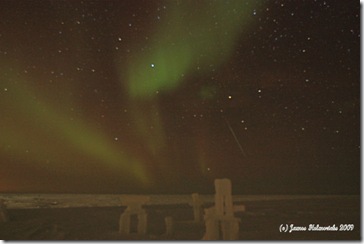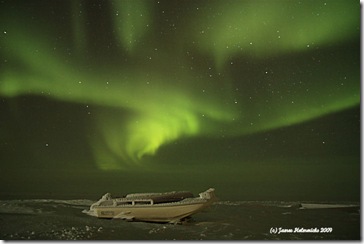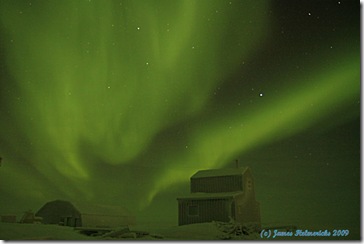I guess our location was to far West and North to see much of the Geminid meteor shower even though we did have good conditions. *See the update I took off Spaceweather.com web site for more info on the meteor shower. I also added the picture taken in Norway of a bright meteor flash from Astronomy’s photo of the day 19 December. * The skies had cleared with the incoming cold weather and I even braved the –25F temperatures for several hours hoping to see and film a bright meteor burning as it entered earths atmosphere.
Five hours of viewing for me produced a total of 20 meteors, most 20 minutes a part. While I didn’t see many meteors, there were several nice Aurora Borealis displays for me to enjoy and it made being out in the cold for the night worthwhile. I even managed to film one very weak meteor in one of my Aurora pictures.
Faint meteor streak above the right ice sculpture.
Frost covered boat with the Aurora shimmering overhead.
A big wide band of green Aurora over houses.
*GEMINID METEOR UPDATE: On Dec. 13th, Earth passed through a stream of debris from extinct comet 3200 Phaethon. The encounter produced a surge of more than 160 Geminid meteors per hour. The timing of the peak favored observers in Europe and the Middle East, many of whom said it was the finest display of Geminids they had ever seen.
Geminids are pieces of debris from a strange object called 3200 Phaethon. Long thought to be an asteroid, Phaethon is now classified as an extinct comet. It is, basically, the rocky skeleton of a comet that lost its ice after too many close encounters with the sun. Earth runs into a stream of debris from 3200 Phaethon every year in mid-December, causing meteors to fly from the constellation Gemini
Astronomy Picture of the Day-December 19, 2009
Aurora Shimmer, Meteor Flash
Credit & Copyright: Bjørnar G. Hansen,
Explanation: Northern Lights, or aurora borealis, haunted skies over the island of Kvaløya, near Tromsø Norway on December 13. This 30 second long exposure records their shimmering glow gently lighting the wintery coastal scene. A study in contrasts, it also captures the sudden flash of a fireball meteor from December's excellent Geminid meteor shower. Streaking past familiar stars in the handle of the Big Dipper, the trail points back toward the constellation Gemini, off the top of the view. Both aurora and meteors occur in Earth's upper atmosphere at altitudes of 100 kilometers or so, but aurora are caused by energetic charged particles from the magnetosphere, while meteors are trails of cosmic dust.




Hi Jim
ReplyDeleteAmazing photos - fabulous. Hope you and Teena had a great Christmas.
Mary Colwell
Thanks Mary,
ReplyDeleteWe had a quite Christmas with just Teena and I at home. Kids all doing fine, just scattered all about Alaska.
Cheers Jim